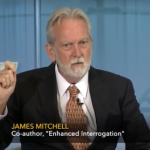Judge Rejects Arguments Of CIA Torture Architects, Allows Lawsuit To Go To Trial

A federal judge allowed a lawsuit against CIA contractors implicated in the torture program to proceed to trial in Spokane, Washington, on September 5.
The suit was brought by the American Civil Liberties Union on behalf of three former detainees—Suleiman Abdullah Salim, Mohamed Ahmed Ben Soud, and the family of Gul Rahman—who were each subjected to torture. It accuses James Mitchell and John “Bruce” Jessen of violations of international law and human rights abuses.
Mitchell and Jessen attempted to persuade Judge Justin Quackenbush to dismiss the lawsuit. They invoked the cases of accused Nazi war criminals to argue they should not be held responsible for the torture techniques they developed.
The ACLU moved for summary judgment, but the judge denied this motion as well.
“This is a historic day for our clients and all who seek accountability for torture,” declared ACLU attorney Dror Ladin. “The court’s ruling means that for the first time, individuals responsible for the brutal and unlawful CIA torture program will face meaningful legal accountability for what they did. Our clients have waited a long time for justice.”
In reviewing the facts, Quackenbush noted [PDF] Mitchell and Jessen were involved in “actual interrogations of certain individuals, including Rahman, which occurred in foreign, secret, locations.”
“The finder of fact could conclude that although the CIA may have maintained ultimate control of the program, defendants, being on site, exercised significant control during individual interrogations,” Quackenbush suggested. “For example, excerpts from Mitchell’s book describe that he decided to deviate from the legal guidance on the length of pours during waterboarding. He states ‘legal guidance said we could pour water between 20 to 40 seconds and then lower the cloth and pour water another 20 to 40 seconds, and so on, for 20 minutes.'”
According to Mitchell, “It quickly became apparent that 20 seconds was too long for the shortest pour,” and he “decided, on the spot, to shorten the pours,” which could be considered evidence that defendants “exercised discretion” in applying torture techniques.
“Defendants have not established they merely acted at the direction of the government, within the scope of their authority, and that such authority was legally and validly conferred,” Quackenbush noted.
The ACLU argues that the two CIA contractors were crucial to the development of the CIA’s torture program. In fact, they were paid millions to provide the “means for the systematic abuse of detainees.”
It is impossible for them to claim ignorance of the pain and suffering their work inflicted upon detainees. For example, in applying torture techniques to Abu Zubaydah, they observed how it led Zubaydah to “vomit, cry, beg, plead, shake, tremble, whimper, moan, desperately pray, and become so hysterical and distressed he could not communicate.”
Quackenbush called attention to “several unconvincing arguments” made by Mitchell and Jessen.
“Defendants argue there were other ‘parallel’ interrogation programs, which is contradicted by [former CIA legal counsel] John Rizzo’s testimony that there was only one legally authorized program,” Quackenbush stated.
“The argument defendants designed the program only for use on HVDs [high value detainees] is unconvincing. Jessen testified the terms ‘evolved over time’ and the term HVD ‘didn’t exist when we started.'”
“The designation of an individual could change, and thus arbitrary. Plaintiff Salim was designated as ‘low level,’ ‘high level’ and ‘no longer enemy combatant,'” according to Quackenbush.
“Further, the designation somewhat speculative – what information does the CIA think the individual possesses.”
To the argument that “there is no connection” between the torture techniques proposed by Mitchell and Jessen and those applied to plaintiffs, Quackenbush described this as “factually incorrect.”
“Some techniques are identical and others appear to be variations–such as water dousing,” Quackenbush declared.
“The evidence would support a finding defendants designed the EITs to be used on detainees, and thus they clearly had knowledge they would be so used,” Quackenbush added. “Whether they had the purpose of facilitating a criminal act is not as clear because of defendants’ testimony about their own actions, whether they believed the could be utilized safely, and whether they relied on legal opinions prepared by the government. Defendants contend they lacked the requisite mens rea because they ‘believed the were legal and appropriate based on the [Office of Legal Counsel] memos” and received constant assurances from .”
Quackenbush contended the former detainees are not required to prove Mitchell or Jessen had the motive to harm them. They could possibly be found liable for actions that led to the abusive treatment of Salim and Soud at COBALT, where they were known to have worked in November 2002 before Salim and Soud arrived.
“Defendants’ briefing in arguing against ‘substantial assistance’ attempts to minimize their participation, and at times goes to incredible lengths: ‘Defendants’ involvement was limited to suggesting potential for Zubaydah, and then providing a detailed list of techniques that had been used at SERE for fifty years.'”
According to Quackenbush, “This statement is factually inaccurate and misleading. It is not credible to argue defendants were paid $80 million dollars for suggesting some techniques the Air Force SERE program already knew about. It is also undisputed that Defendants did not merely suggest . They actually applied to Zubaydah, interrogated Rahman, and participated in the program for several years.”
Mitchell and Jessen attempted to have the Senate Select Committee on Intelligence’s study of the CIA’s rendition, detention, and interrogation program excluded from trial as “hearsay.” The judge rejected their arguments, including the notion that the committee “was not qualified to investigate the program” and they “produced an untrustworthy, partisan, and unreliable report.”
![]()
